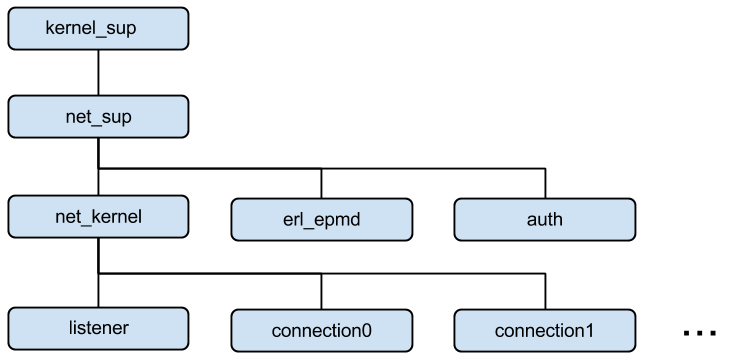Distributed Erlang
This document is a short guide to the structure and internals of the Erlang/OTP distributed messaging facility.
The intended audience is Erlang programmers with experience using distributed Erlang and an interest in its implementation.
Overview
The protocol Erlang nodes use to communicate is described between the distribution protocol and external term format sections of the ERTS user guide.
The implementation is supported by features of the system applications, libraries, and the BEAM emulator.
Sections below describe process structure, flow of control, and points of
contact between subsystems, with links to the source code at a recent commit
hash on the maint
branch.
Transport
The distributed protocol typically uses a single TCP socket over IPv4. The protocol used can be specified with the proto_dist argument to the VM, and is respected by the net_kernel module when it sets up either its own distributed listener or connects to remote nodes.
To find the protocol modules specified by proto_dist, add _dist.erl in the
Erlang/OTP source.
- inet_tcp, the default; handles TCP streams with IPv4 addressing.
- inet6_tcp,
an undocumented module prepared to handle TCP with IPv6 addressing. In
principle there’s no reason
inet_tcpcould not be protocol-agnostic in this respect, but for now programmers setting up nodes on IPv6 networks need to specify-proto_dist inet6_tcp. - inet_tls, connection using TLS to verify clients and encrypt internode traffic. Setup is detailed in the Secure Socket Layer User’s Guide. Note that particularly within Erlang’s usual LAN deployment context, other options such as an internode VPN might be more convenient.
As well as transport negotation, the protocol modules handle node registration and lookup, so a particular transport could use something other than epmd if required.
Discovery
Before applications on the network can talk, they need to locate one another with some form of service discovery. Erlang/OTP relies on both DNS and a portmap-style service called epmd (for “Erlang Port Mapping Daemon”).
epmd is a simple standalone daemon written in
C which listens at port
4369 on a host running Erlang nodes. It implements a simple binary protocol to
register and look up (Erlang node, TCP port) mappings. See the links from
the overview above for details.
The Erlang system applications interact with epmd via the erl_epmd
module.
Notes:
- An Erlang node starts
epmdautomatically if it is not already running on the host at startup. This is built in to the low-levelerlexecC program used byerlto invoke the emulator. - Each node registering itself with
epmdmaintains its open TCP connection after sendingALIVE2_REQ;epmdderegisters the node when that connection is closed or lost. - The
Extrafield ofALIVE2_REQis faithfully stored and echoed back byepmdinPORT2_RESPresponses, but is not currently used. - Both
NameandExtracan have a maximum size of MAXSYMLEN.
System
Setup and maintenance of distributed Erlang listening and connection is handled by the kernel application’s net_kernel module.
The process hierarchy:

net_kernel is started by the net_sup
supervisor,
if it can find -sname or -name arguments on the erl commandline. Started
alongside it are
erl_epmd
and auth.
All three are gen_servers. The latter two respectively handle maintaining a
connection to epmd, as discussed above, and
cookie
management (including the backend for erlang:{set,get}_cookie).
net_kernel immediately sets up a listening socket for the node by invoking
Mod:listen/1 for the proto_dist module (by default
inet_tcp_dist).
Note the facility to supply listen
options
for distributed Erlang sockets via the commandline.
After registering this as the node’s distribution socket with the emulator (via
erlang:setnode/2, see below), net_kernel invokes Mod:accept/1, e.g. for
inet_tcp_dist.
By default, this creates the listener process in the diagram above, running
inet_tcp_dist:accept_loop/2.
After this, there are two cases for net_kernel to deal with:
-
An incoming connection from another node. This triggers a call to the proto_dist
Mod:accept_connection/5which in turn starts one of theconnectionNprocesses in the diagram above and performs the distributed Erlang handshake using the dist_util module. On a successful handshake,dist_util:do_setnode/1registers the newly connected node with the emulator (viaerlang:setnode/3, see below). -
An outgoing connection to another node. This is handled by
net_kernel:connect/1, which is called transparently by thed*functions in the erlang module (see the emulator section below).net_kernel:connect/1does much the same work as for an incoming connection (including setting up one of theconnectionNprocesses in the diagram above), but viaMod:setup/5in theproto_distmodule.
Finally, note that net_kernel can also be
invoked
as part of the
erlang:spawn/4 to spawn
processes on a foreign node.
Emulator
While the Erlang system, via net_kernel, handles connection setup, the nuts
and bolts of the distributed Erlang protocol are handled by the emulator
itself. The API it exposes is small, however, and mostly found in the built-in
functions registered by
dist.c.
First up are the setnode BIFs. These register either the local node
(erlang:setnode/2) or remote nodes (erlang:setnode/3) in the emulator’s
node
tables.
There are separate distribution tables for visible and hidden nodes; this is
how the -hidden node commandline argument is used. The erlang:nodes/0 BIF
reads these tables directly.
BIFs like
erlang:send/2
look up the node tables and call into the erts_dsig_*
functions
to handle distributed messaging. If a connection is necessary, these can trap
back to e.g.
erlang:dsend/2
to invoke connection setup via net_kernel.
Once connections are established, erts_dsig_send_* are used to do the actual messaging. Message encoding in the external term format is handled by dsig_send.
Updates
Please send any comments or suggestions for this document to cian@emauton.org.